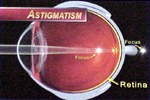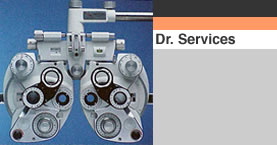Q:
I love my new progressive bifocal, but why don't they work so
well at my computer? |
Ask Dr. Chet
A: Progressive Addition Lenses have a variable focus that
allows for clear vision from distance through near; today's newer
designs have been compressed to fit into smaller size frames.
While Progressive Addition Lenses work great for almost all situations
because of that variable focus ability, computer work is a tough
situation for many people with no great solution for some.
To allow for maximum size of the reading zone and minimal interference
with clear distance viewing, the compromise with the new progressive
designs is to shorten the mid-range zone, which is the part that
is in focus at the usual distance of the CRT screen. Since the
CRT screen is usually at eye level, it requires a head tilt back
to put that mid-range focus zone in view of our eyes. We then
get a combination that is less than optimal for some people.
Some suggestions to help are: 1. Back the monitor away and raise
it up so the distance part of the lens can be used. 2. Lower the
monitor so it is in view of the reading zone. 3. Consider a pair
of computer glasses that have only midrange and near, or single
vision near only. 4. Get a notebook computer, as these sit on
the desk usually within the mid-range and near zone of the lens.
5. Consider line segment bifocals or trifocals.
The use of computers and a potential need for bifocals should
be discussed with your doctor and/or your optician to maximize
performance and comfort in this situation.
Q:
What exactly is astigmatism? |
Ask Dr. Chet
A: We see an object clearly when light from it or reflecting off
it enters the eye and forms a focused image on the retina. Consider
the simplest example of this, a point source of light like a star.
If there is no astigmatism present, light entering the eye from
the star will be focused forming an image that is also a point.
(If the focused image forms in front of the retina, the eye is myopic
or nearsighted. If it forms in back of the retina, the eye is hyperopic
or farsighted. If it forms on the retina, there is no refractive
error and the eye is said to be emmetropic.)
 If there is astigmatism present, the light from the star will not
focus as a point but instead will be distorted. (Actually, the image
of the star focuses as two lines, one in front of the other and
separated by some distance, with one line oriented 90 degrees from
the other.) Don't bother trying to understand what astigmatism is.
Just remember it distorts vision and can be corrected with special
lenses called cylinders. The cornea having a shape that resembles
a football instead of the normal case, a basketball, usually causes
astigmatism. In most cases astigmatism occurs with either myopia
or hyperopia. Some people have astigmatism only but not many. Astigmatism
can be easily corrected with glasses, with rigid glass permeable
contact lenses or with so-called "toric" soft contact
lenses. "Toric" refers to the shape of one of the lens
surfaces. It is the toric surface that is responsible for correcting
the astigmatism.
If there is astigmatism present, the light from the star will not
focus as a point but instead will be distorted. (Actually, the image
of the star focuses as two lines, one in front of the other and
separated by some distance, with one line oriented 90 degrees from
the other.) Don't bother trying to understand what astigmatism is.
Just remember it distorts vision and can be corrected with special
lenses called cylinders. The cornea having a shape that resembles
a football instead of the normal case, a basketball, usually causes
astigmatism. In most cases astigmatism occurs with either myopia
or hyperopia. Some people have astigmatism only but not many. Astigmatism
can be easily corrected with glasses, with rigid glass permeable
contact lenses or with so-called "toric" soft contact
lenses. "Toric" refers to the shape of one of the lens
surfaces. It is the toric surface that is responsible for correcting
the astigmatism.
Home
| Ask Dr. Chet | Site
Map | Copyrights
| Privacy
Policy





